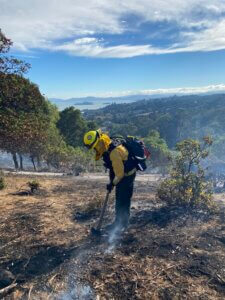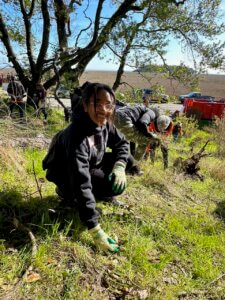
Burning news
Key steps to reduce catastrophic wildfire risk
With its lush meadows and dense forests, China Camp stands out as a wild and leafy retreat overlooking San Pablo Bay. But the roughly 1,500-acre park, bounded by residential areas and public open space, is not an island, and all that lushness and built-up fuel needs to be managed safely to reduce the risk of catastrophic wildfires in our area.
That’s why Friends of China Camp has teamed up with partners and neighboring stakeholders to reduce the risk of out-of-control fires in our region. Here’s a look at key steps taken to date and what’s in store.
Major removal of invasive species and excess fuels. As is true all over the state, this has been an important focus for fire-management efforts in the West. Friends of China Camp volunteer David Littlejohn, who spearheads our invasive plant removal efforts, stresses that these plants can pose significant fire risks.
“Invasive plants tend to grow quickly in order to out-compete with native plants,” David explains. “And when conditions are suitable, they can form dense thickets. These plants, both alive and dead, significantly elevate the fire risk by providing additional fuel for wildland fires. They can also create ‘fire ladders’ which transfer ground fires into trees.”
 The months on either side of the winter rainy season are prime time for removing overgrown invasives and built-up deadwood. So, in February of last year, the California Department of Parks and Recreation brought in crews to tackle fuel reduction and removal of invasives in targeted areas, including China Camp Village and the hillsides above China Camp’s southeastern entrance. French and Scotch broom, acacia, eucalyptus, and Monterey pine, as well as woody shrubs, were cut down and removed. This thinning work, part of a multi-year plan, resumed in October, with crews moving east along the ridgeline above the ranger station.
The months on either side of the winter rainy season are prime time for removing overgrown invasives and built-up deadwood. So, in February of last year, the California Department of Parks and Recreation brought in crews to tackle fuel reduction and removal of invasives in targeted areas, including China Camp Village and the hillsides above China Camp’s southeastern entrance. French and Scotch broom, acacia, eucalyptus, and Monterey pine, as well as woody shrubs, were cut down and removed. This thinning work, part of a multi-year plan, resumed in October, with crews moving east along the ridgeline above the ranger station.
Other agencies were busy protecting China Camp’s ridgeline. In June the San Rafael Fire Department spearheaded a project to remove overgrown and invasive vegetation from the fire roads (Bay Hills, Bay View, and Gold Hill) lacing the southeast end of San Pedro Ridge.
Prescribed burns to reduce fuel load. This past fall, you may have spotted plumes of gray-white smoke rising above China Camp. While these might have looked scary, the scheduled burns were in fact a positive step toward removing natural fuel and reducing the risk of a catastrophic wildfire. They also aimed to preserve and improve China Camp’s natural ecosystems and habitats, particularly its oak woodlands and grasslands.
Preparation for the burns started earlier in the year. The Marin County Fire Department, in cooperation with California State Parks, the San Rafael Fire Department, and the Marin Wildfire Protection Authority, thinned vegetation along the McNear Fire Trail and Oak Ridge Trail. Vegetation was then burned in a pair of prescribed fires in late October and early November.
Large community and partner events. In addition to including invasive plant removal as a regular part of the park’s weekly trail maintenance workdays, Friends of China Camp has also scheduled larger events, inviting community members, service organizations, and local and state agencies to help.
 For example, on Earth Day this past April, FOCC co-sponsored an event with the California State Parks Foundation. On a brilliant spring morning, over 50 enthusiastic volunteers got inspired by the supportive words of California State Parks Director (and San Rafael resident) Armando Quintero, State Assemblyman Damon Connolly, and Rachel Kurtz, member of the San Rafael City Council. Then everyone donned their gloves and fanned out to pull, yank, clip, and haul out hundreds of invasive and flammable broom plants and dead woody shrubs near the park’s northwestern border.
For example, on Earth Day this past April, FOCC co-sponsored an event with the California State Parks Foundation. On a brilliant spring morning, over 50 enthusiastic volunteers got inspired by the supportive words of California State Parks Director (and San Rafael resident) Armando Quintero, State Assemblyman Damon Connolly, and Rachel Kurtz, member of the San Rafael City Council. Then everyone donned their gloves and fanned out to pull, yank, clip, and haul out hundreds of invasive and flammable broom plants and dead woody shrubs near the park’s northwestern border.
In late July, at another event co-sponsored by FOCC and the California State Parks Foundation, over 30 volunteers thinned vegetation along the trailhead at the top of Knight Drive. And in September, Friends of China Camp partnered with neighbors for a brush clearing and invasive plant removal project just outside the park’s northwestern border near Buck’s Landing.
Regular volunteer events throughout the year. Our trail maintenance volunteers regularly remove invasives and keep trails clear during our weekly workdays. Larger community projects are also planned throughout the year. You are welcome to join us at any of these events. We can promise you that you’ll make a difference, and hopefully have fun and get a good workout too. Check our events page for details, and follow us on Instagram and Facebook for future announcements.
—Kevin Smead/FOCC volunteer

